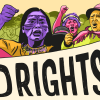Sept. 11, 2015
Andy White, the Coordinator of the Rights and Research Initiative (RRI) introduces a new report.
A new, unprecedented legal analysis has revealed that despite using and inhabiting up to 65% of the world’s land, Indigenous Peoples and local communities—a population up to 2.5 billion—possess legal rights to barely 18%.
That’s a huge gap. And it’s a gap that explains a lot of widespread disenfranchisement, poverty, and conflict across the world. The right to land and natural resources is not just a basic human right, it is also linked to many key development indicators—from food security, poverty eradication, and gender equality to combating climate change, deforestation, and displacement.
For indigenous and local communities, the relationship to land is a vital component of culture as well as survival. When that relationship is trampled, the resulting disenfranchisement can become a gateway to social, often violent conflict.
It is no surprise then that according to the study, almost 100% of land in 10 out of 12 countries listed as fragile states by the World Bank is owned by the government or private sector, and not the people who have actually lived there for generations. In fact, disputes over land and natural resources are a major contributing cause of armed conflict across the world.
The study, conducted by the Rights and Resources Initiative (RRI), gives us for the first time an international baseline of the amount of land that’s legally recognized as owned or administered by Indigenous Peoples and communities. It identifies the land area in 64 countries (over 80% of the world’s total land surface) that’s formally recognized under national laws as owned or controlled by Indigenous Peoples and local communities. It covers drylands, grasslands, forests, and most other rural areas.
This study also establishes a baseline of country performance on legal recognition—finding for example that more than half of all of the countries studied have no legal avenue whatsoever to enable recognition. It also identifies the countries that do have such court rulings or laws, but have yet to implement them. Ultimately, it shows us where we have solid potential for progress, and hands us a tool with which to measure it.
An Indonesia Constitutional Court ruling in 2013, for example, invalidated government control of the country’s customary forests. If and when this ruling is implemented, it could increase the amount of land owned or controlled by Indigenous Peoples and local communities from 0.25 percent of the national territory to approximately 23 percent—a real game-changer for millions of Indonesians.
Good for people; good for the planet
Past research comparing the impact of strong land rights on the health of rural lands and natural resources has foundWho owns the land that Indigenous Peoples and local communities conserve the nature of their territories best, keeping the carbon in the trees and ground and thus slowing climate change.
For instance, indigenous reserves in the Brazilian Amazon have played a critical role in lowering national deforestation rates, and increased forest rights for farmers in Niger have added 200 million new trees over the past 20 years, storing an additional 30 million tonnes of carbon.
Here’s why that matters: Indigenous Peoples and local communities today have legal or official rights to at least 513 million hectares of forests, about 1/8th of the world’s total forest and around half of the forests they actively use or claim. Collectively, this area contains approximately 37.7 billion tonnes of carbon—29 times more than the annual emissions of the world’s passenger vehicles! Recognizing and securing local peoples’ rights to the remainder of their forests is an essential strategy to reduce deforestation and climate change.
Unfortunately, efforts to monetize and trade the carbon found in these forests on the open market has given national governments yet another reason to seize control from the local residents—even though those residents have kept the forests standing since before most governments even came into the picture.
A trigger for renewed efforts?
Here’s that potential for progress that gives us hope. Several countries in the survey have laws that could dramatically expand legal recognition for Indigenous Peoples/local communities if they were implemented in letter and spirit. One great example is India.
In India, we found that a landmark forest legislation Act passed in 2006 obligates the state to recognize the rights of approximately 150 million forest dwellers on at least 40 million hectares of forested land. We also saw that the districts with the largest eligibility for land rights recognition also contain the country’s poorest areas, signaling huge potential for economic progress. They are also the districts with the maximum number of land-based social conflicts.
So while implementation of India’s Forest Rights Act has been stalled for almost a decade, this year, the current government rejuvenated efforts to address the issue. As promising as this is, it remains to be seen if the government will fight off competing private sector interests and its own economic ambitions to keep up those efforts.
In fact, over the past two years, there have been numerous commitments from both governments and the private sector, from the New York Declaration on Forests to the Liberian and Indonesian governments’ pledges to recognize their local peoples’ rights. But so far, these remain promises. While the intent is laudable, the reality is that Indigenous Peoples and local communities in far too many countries still lack participation and ownership in decisions affecting their land, resources, and livelihoods.
Fortunately, there are now new tools and mechanisms in place, as well as a global call to action for all key actors to scale-up efforts on these commitments. We also have lessons to learn from countries that have implemented good land rights legislation and reaped benefits. It’s time to shift from rhetoric to action, and that’s what the upcoming international conference on community land and resource rights, where this study is being released, hopes to achieve.
The study is being released today at a conference in Bern, Switzerland, co-organized by RRI, the International Land Coalition (ILC), Oxfam, and Helvetas Swiss Intercooperation.
By Duncan Green


